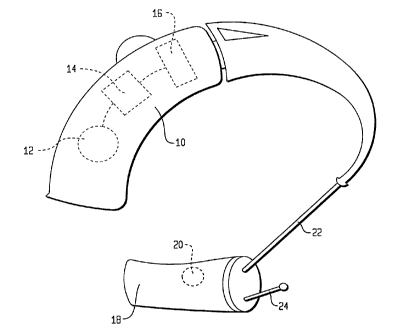Une partie des informations de ce site Web a été fournie par des sources externes. Le gouvernement du Canada n'assume aucune responsabilité concernant la précision, l'actualité ou la fiabilité des informations fournies par les sources externes. Les utilisateurs qui désirent employer cette information devraient consulter directement la source des informations. Le contenu fourni par les sources externes n'est pas assujetti aux exigences sur les langues officielles, la protection des renseignements personnels et l'accessibilité.
L'apparition de différences dans le texte et l'image des Revendications et de l'Abrégé dépend du moment auquel le document est publié. Les textes des Revendications et de l'Abrégé sont affichés :
| (12) Brevet: | (11) CA 2224653 |
|---|---|
| (54) Titre français: | PROTHESE AUDITIVE HYBRIDE "CONTOUR D'OREILLE" ET A INSERER ENTIEREMENT DANS LE CANAL AUDITIF |
| (54) Titre anglais: | HYBRID BEHIND-THE-EAR AND COMPLETELY-IN-CANAL HEARING AID |
| Statut: | Périmé |
| (51) Classification internationale des brevets (CIB): |
|
|---|---|
| (72) Inventeurs : |
|
| (73) Titulaires : |
|
| (71) Demandeurs : |
|
| (74) Agent: | ROBIC |
| (74) Co-agent: | |
| (45) Délivré: | 2006-10-10 |
| (86) Date de dépôt PCT: | 1996-05-29 |
| (87) Mise à la disponibilité du public: | 1997-01-03 |
| Requête d'examen: | 2003-05-26 |
| Licence disponible: | S.O. |
| (25) Langue des documents déposés: | Anglais |
| Traité de coopération en matière de brevets (PCT): | Oui |
|---|---|
| (86) Numéro de la demande PCT: | PCT/US1996/007910 |
| (87) Numéro de publication internationale PCT: | WO1997/000593 |
| (85) Entrée nationale: | 1997-12-12 |
| (30) Données de priorité de la demande: | ||||||
|---|---|---|---|---|---|---|
|
La prothèse auditive hybride décrite, du type "contour d'oreille" et à insérer entièrement dans le canal auditif comprend un élément contour d'oreille porté derrière l'oreille du patient et un élément à insérer entièrement, se portant dans la partie osseuse du canal auditif du patient. Les deux éléments sont reliés l'un à l'autre par un fil métallique. Le retour électro-acoustique est réduit ou éliminé dans cette prothèse, ce qui permet d'en accroître le gain. Le patient n'est pas dérangé par l'effet d'occlusion.
A hybrid BTE and CIC hearing aid
has a BTE component which is worn behind
the patient's ear and a CIC component
which is worn in the bony portion of the
patient's ear canal. The BTE and CIC
components are connected together with a
wire cable. Electroacoustic feedback is
reduced or eliminated, allowing gain to be
increased. The patient is not disturbed by
the occlusion effect.
Note : Les revendications sont présentées dans la langue officielle dans laquelle elles ont été soumises.
Note : Les descriptions sont présentées dans la langue officielle dans laquelle elles ont été soumises.

Pour une meilleure compréhension de l'état de la demande ou brevet qui figure sur cette page, la rubrique Mise en garde , et les descriptions de Brevet , États administratifs , Taxes périodiques et Historique des paiements devraient être consultées.
| Titre | Date |
|---|---|
| Date de délivrance prévu | 2006-10-10 |
| (86) Date de dépôt PCT | 1996-05-29 |
| (87) Date de publication PCT | 1997-01-03 |
| (85) Entrée nationale | 1997-12-12 |
| Requête d'examen | 2003-05-26 |
| (45) Délivré | 2006-10-10 |
| Expiré | 2016-05-30 |
Il n'y a pas d'historique d'abandonnement
Les titulaires actuels et antérieures au dossier sont affichés en ordre alphabétique.
| Titulaires actuels au dossier |
|---|
| HEAR-WEAR, L.L.C. |
| Titulaires antérieures au dossier |
|---|
| BERKHOLCS, GORDON |
| CLEAR-TONE HEARING AID LABORATORIES, INC. |
| REITER, JAMES J. |
| SIEMENS HEARING INSTRUMENTS, INC. |